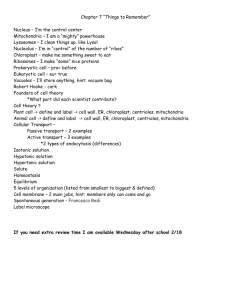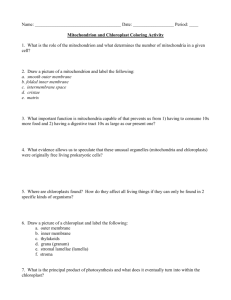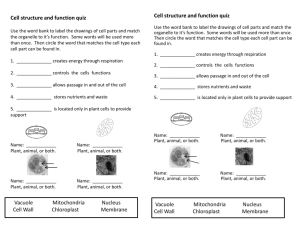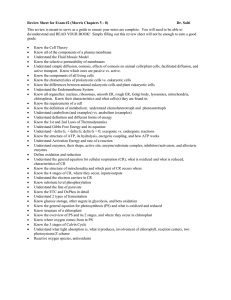Quiz Grade 11 HL Biology Chapter 1.5
advertisement
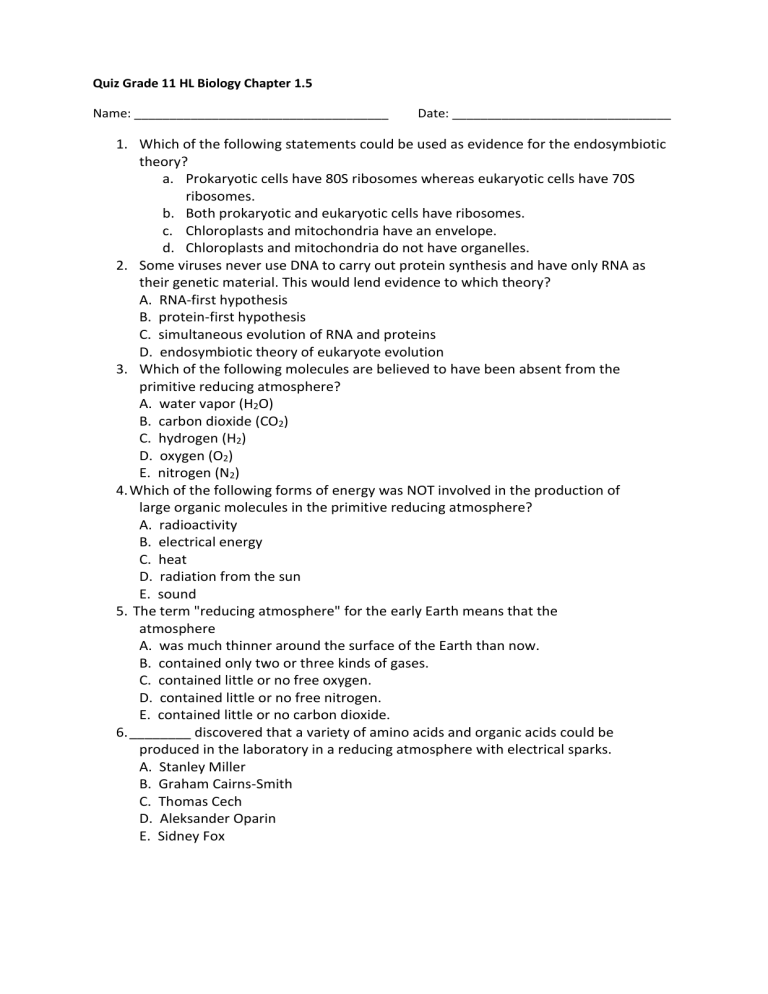
Quiz Grade 11 HL Biology Chapter 1.5 Name: ____________________________________ Date: _______________________________ 1. Which of the following statements could be used as evidence for the endosymbiotic theory? a. Prokaryotic cells have 80S ribosomes whereas eukaryotic cells have 70S ribosomes. b. Both prokaryotic and eukaryotic cells have ribosomes. c. Chloroplasts and mitochondria have an envelope. d. Chloroplasts and mitochondria do not have organelles. 2. Some viruses never use DNA to carry out protein synthesis and have only RNA as their genetic material. This would lend evidence to which theory? A. RNA-first hypothesis B. protein-first hypothesis C. simultaneous evolution of RNA and proteins D. endosymbiotic theory of eukaryote evolution 3. Which of the following molecules are believed to have been absent from the primitive reducing atmosphere? A. water vapor (H2O) B. carbon dioxide (CO2) C. hydrogen (H2) D. oxygen (O2) E. nitrogen (N2) 4. Which of the following forms of energy was NOT involved in the production of large organic molecules in the primitive reducing atmosphere? A. radioactivity B. electrical energy C. heat D. radiation from the sun E. sound 5. The term "reducing atmosphere" for the early Earth means that the atmosphere A. was much thinner around the surface of the Earth than now. B. contained only two or three kinds of gases. C. contained little or no free oxygen. D. contained little or no free nitrogen. E. contained little or no carbon dioxide. 6. ________ discovered that a variety of amino acids and organic acids could be produced in the laboratory in a reducing atmosphere with electrical sparks. A. Stanley Miller B. Graham Cairns-Smith C. Thomas Cech D. Aleksander Oparin E. Sidney Fox 7. The fact that a nucleic acid is a very complicated molecule suggests that A. the RNA-first hypothesis is impossible. B. RNA could not have arisen on its own by chance, but required enzymes to guide the synthesis of nucleotides and then nucleic acids. C. sophisticated enzymes were not present or available to synthesize it. D. no natural system could ever generate it. E. the protein-first hypothesis is therefore the only plausible hypothesis. 8. It is likely that the protocell was A. heterotrophic. B. chemoautotrophic. C. photoautotrophic. D. All of the above. E. Either heterotrophic or chemoautotrophic. 9. The formation of simple organic monomers, such as sugars, amino acids, and nucleotide bases, from inorganic molecules is A. biosynthesis. B. genetically modified photosynthesis. C. abiotic synthesis. D. chemoautotrophic activity. 10. Which piece of evidence best supports the endosymbiotic theory of organelle evolution? A. Mitochondria and chloroplast are the same size as bacteria. B. Mitochondria and chloroplast divide by binary fission. C. Mitochondria and chloroplast both contain DNA and some can make their own proteins. D. The outer membrane of chloroplast and mitochondria resemble that of a eukaryotic cell while the inner membrane resembles that of a bacterial cell. E. All of the above are correct. 11. Which piece of evidence best supports the endosymbiotic theory of organelle evolution? A. The outer membrane of a mitochondrion and chloroplast resemble a eukaryotic cell while the inner membrane resembles that of a bacterial cell. B. The inner membrane of a mitochondrion and chloroplast resemble a eukaryotic cell while the outer membrane resembles that of a bacterial cell. C. Both mitochondria and chloroplast divide by Mitosis. D. Mitochondria and chloroplast are much larger than present day bacteria. 12. State four pieces of evidence for the endosymbiotic theory.
